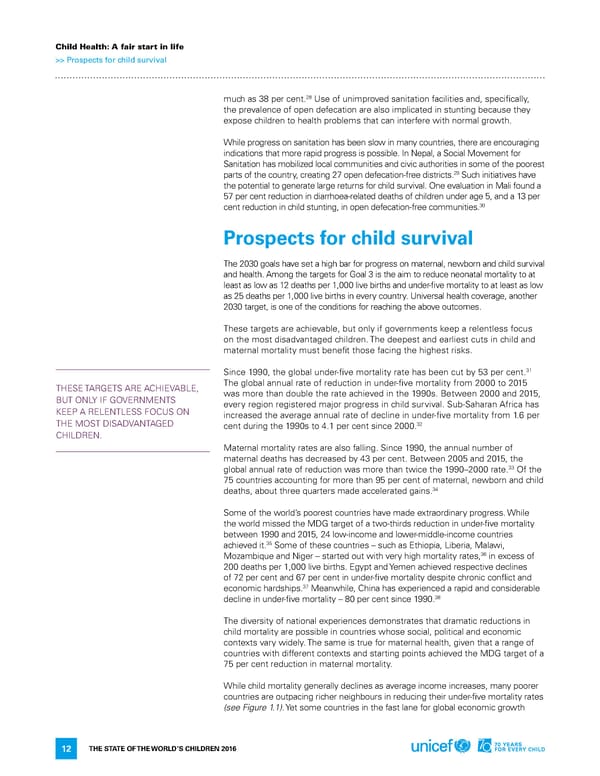Child Health: A fair start in life >> Prospects for child survival 28 much as 38 per cent. Use of unimproved sanitation facilities and, specifically, the prevalence of open defecation are also implicated in stunting because they expose children to health problems that can interfere with normal growth. While progress on sanitation has been slow in many countries, there are encouraging indications that more rapid progress is possible. in nepal, a Social Movement for Sanitation has mobilized local communities and civic authorities in some of the poorest 29 parts of the country, creating 27 open defecation-free districts. Such initiatives have the potential to generate large returns for child survival. one evaluation in Mali found a 57 per cent reduction in diarrhoea-related deaths of children under age 5, and a 13 per 30 cent reduction in child stunting, in open defecation-free communities. Prospects for child survival The 2030 goals have set a high bar for progress on maternal, newborn and child survival and health. among the targets for Goal 3 is the aim to reduce neonatal mortality to at least as low as 12 deaths per 1,000 live births and under-five mortality to at least as low as 25 deaths per 1,000 live births in every country. Universal health coverage, another 2030 target, is one of the conditions for reaching the above outcomes. These targets are achievable, but only if governments keep a relentless focus on the most disadvantaged children. The deepest and earliest cuts in child and maternal mortality must benefit those facing the highest risks. 31 Since 1990, the global under-five mortality rate has been cut by 53 per cent. TheSe TarGeTS are aChieVaBle, The global annual rate of reduction in under-five mortality from 2000 to 2015 BUT onlY if GoVernMenTS was more than double the rate achieved in the 1990s. Between 2000 and 2015, KeeP a relenTleSS foCUS on every region registered major progress in child survival. Sub-Saharan africa has increased the average annual rate of decline in under-five mortality from 1.6 per The MoST diSadVanTaGed 32 cent during the 1990s to 4.1 per cent since 2000. Children. Maternal mortality rates are also falling. Since 1990, the annual number of maternal deaths has decreased by 43 per cent. Between 2005 and 2015, the 33 global annual rate of reduction was more than twice the 1990–2000 rate. of the 75 countries accounting for more than 95 per cent of maternal, newborn and child 34 deaths, about three quarters made accelerated gains. Some of the world’s poorest countries have made extraordinary progress. While the world missed the MdG target of a two-thirds reduction in under-five mortality between 1990 and 2015, 24 low-income and lower-middle-income countries 35 achieved it. Some of these countries – such as ethiopia, liberia, Malawi, 36 Mozambique and niger – started out with very high mortality rates, in excess of 200 deaths per 1,000 live births. egypt and Yemen achieved respective declines of 72 per cent and 67 per cent in under-five mortality despite chronic conflict and 37 economic hardships. Meanwhile, China has experienced a rapid and considerable 38 decline in under-five mortality – 80 per cent since 1990. The diversity of national experiences demonstrates that dramatic reductions in child mortality are possible in countries whose social, political and economic contexts vary widely. The same is true for maternal health, given that a range of countries with different contexts and starting points achieved the MdG target of a 75 per cent reduction in maternal mortality. While child mortality generally declines as average income increases, many poorer countries are outpacing richer neighbours in reducing their under-five mortality rates (see Figure 1.1). Yet some countries in the fast lane for global economic growth The STaTe of The World’S Children 2016 12
 70 Years for Every Child Page 26 Page 28
70 Years for Every Child Page 26 Page 28